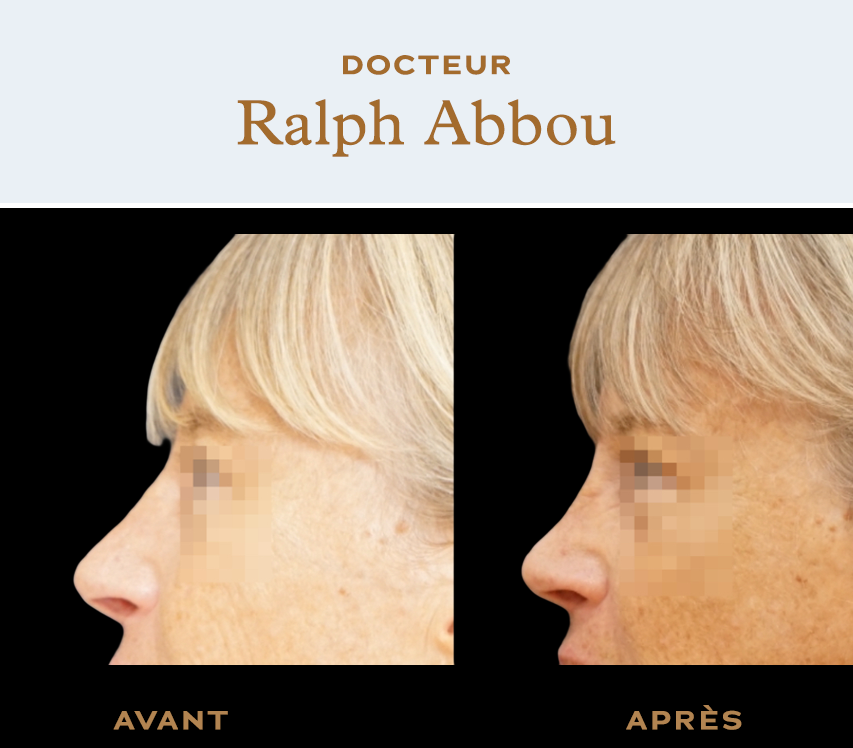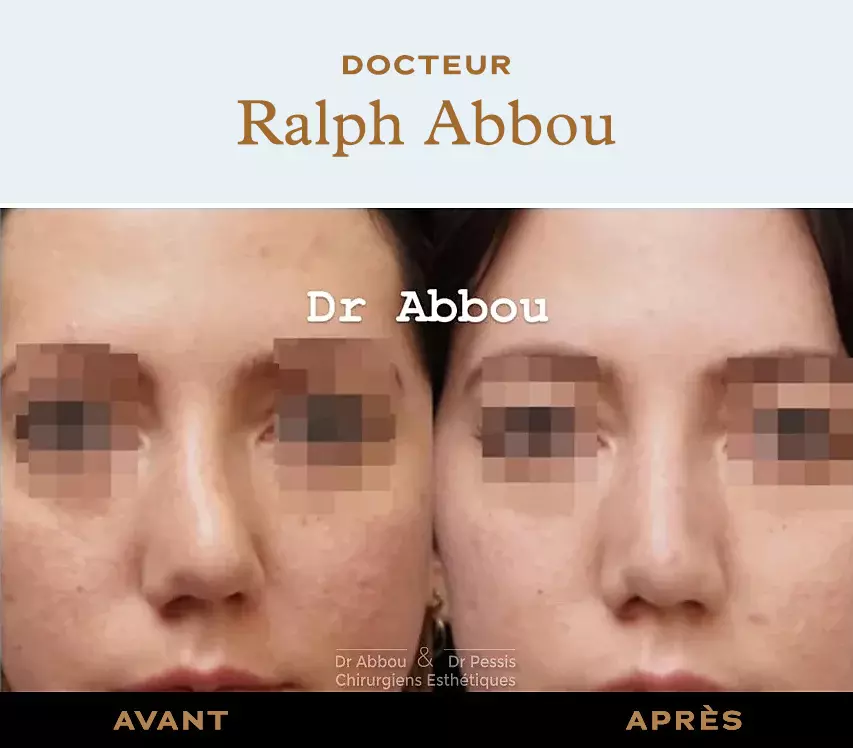Revision rhinoplasty Paris
A revision rhinoplasty is a surgical procedure to correct undesirable results or complications that occur after a failed primary or initial rhinoplasty. Secondary rhinoplasty is more complex than the initial procedure because of scar fibrosis and the unpredictability of secondary healing.
Revision rhinoplasty can only be considered once the postoperative period of the first operation is over, 12 to 18 months after the initial operation.
This nasal surgery allows the improvement of the result obtained at the level of the tip of the nose, the nasal cartilage and the nasal bone.
In some cases, it can be performed without surgery by hyaluronic acid injections for minor corrections.
This medical information page was written by Dr Ralph ABBOU, plastic surgeon in Paris specializing in rhinoplasty.
Dr Ralph ABBOU defended his medical thesis on the subject of rhinoplasty and has published several scientific publications on this subject.
Dr Ralph ABBOU participates in several congresses per year in France and abroad in order to maintain and perfect his theoretical and technical skills.
For any inquiry please send us a whatsapp message + 33 7 56 86 66 55 or an email at [email protected]
Before and after photos of revision revision rhinoplasty in Paris
What is a revision rhinoplasty ?
Secondary rhinoplasty is used to treat undesirable results following a first nose job:
- Aesthetic problems (drooping tip, corbin’s beak, persistent nose bump, irregularities of the nose, wide tip)
- Respiratory problems of the nose: collapsed nostrils, pathological scarring
The emotional impact of a failed rhinoplasty is significant because the patient is left with a disappointing facial appearance.
In addition to the aesthetic deformity, damage to the tip cartilage often leads to breathing problems.
Why consider secondary nose surgery?
The goals of revision rhinoplasty are:
- Rejuvenated facial appearance
- Reshaping of the nose for a more youthful and balanced appearance.
- Improved breathing with septoplasty and cartilage grafts
- Improved facial symmetry
- Removal of a nasal obstruction or collapsed nose
- Correction of a drooping, round or globular nasal tip or a crooked nose.
- Increased self-confidence: it revitalizes the appearance of the face and the shape of the nose.
- Improvement of the aesthetics of the nose and face
Restoring a damaged nose through surgery may seem deceptively simple. In reality, the medical challenge is considerable.
Secondary rhinoplasty is much more complex than the initial operation. Bone components and cartilage cells are remodeled to reinforce or replace collapsed, twisted or even missing structures.
For these reasons, it is considered one of the most difficult of all cosmetic and reconstructive surgery procedures.
Revision rhinoplasty price Paris
| Surgical intervention | Price |
|---|---|
| Revision rhinoplasty | From 8000€ |
The fee depends on the complexity of your case, the need for cartilage grafting or nose reconstruction.
Who are the candidates for revision rhinoplasty?
It is intended for all patients who have undergone a first operation and who wish to improve the aesthetic result obtained or to breathe better (functional)
During your consultation, I will explain the benefits and risks. If the benefit-risk balance is not in your favor, I will advise you against having the operation.
FAQs
Questions & Answers
What are the differences between primary and secondary rhinoplasty ?
Primary rhinoplasty is one of the most popular facial plastic surgeries to reshape the nose:
- It improves the aesthetics of the face and the shape of the nose
- It treats a deviated septum and a deviated septum
- It treats respiratory problems
- It allows the treatment of defects of the nose or the skin of the nose (beak of corbin, hump, point of the nose falling…)
A second intervention is performed when the first is not successful:
- It is longer than the first procedure.
- It is more complex because it is necessary to repair the structures damaged by excessive resections (cartilage, bone, muscle)
- The postoperative period is longer because of the postoperative swelling.
A revision treatment requires a specialist plastic surgeon who masters the necessary surgical techniques after failures.
Why have a secondary rhinoplasty ?
Patients have recourse to it when there are aesthetic defects after a first unsuccessful operation (beak, drooping tip, nose too hollow) or functional defects i.e. difficulty in breathing not caused by an ENT pathology.
Does it require cartilage grafts ?
A successful secondary rhinoplasty almost always requires cartilage grafts. Even patients seeking a smaller, more delicate nose may require a cartilage graft inside the nose.
The human body has three sources of cartilage of different shapes, sizes and consistencies:
- the cartilage of the nasal septum (nasal septum)
- the concha of the ear or auricular cartilage
- costal cartilage for complex reconstructions
What are its advantages and disadvantages?
Benefits:
- Nasal revision surgery can correct both cosmetic problems such as a pinched nasal tip, thin dorsum or nasal hump and functional problems such as breathing problems.
- It is a procedure that is not too painful.
- A good result can create more balance in your facial features and increase your confidence.
- Any scarring will fade and become virtually impossible to detect.
Disadvantages:
- Two weeks of downtime after nasal surgery due to bruising and swelling.
- It will take at least a year to see your final result and, as with your first surgery, the result may not be as desired.
- It is widely known as one of the most technical and difficult facial plastic surgery procedures, requiring meticulous surgical techniques.
- Revision surgery is expensive
How to have a more beautiful nose?
To have a more beautiful nose, you must be able to analyze what bothers you with your current nose (bump, length of the nose …) and define a precise treatment plan with your plastic surgeon.
When to do this second operation?
It is recommended if your rhinoplasty did not bring you satisfaction on the aesthetic level, if there are still defects and if you do not breathe well at least 12 to 18 months after your first rhinoplasty.
Is it covered?
It is managed only in cases of significant respiratory discomfort or after a trauma.
Avez vous aimé cet article ?
Cliquez sur les étoiles pour donner une note
Note moyenne 5 / 5. Nombre de votes : 61
Pas de votes pour le moment, soyez le premier à voter.













Hello,
Is it possible to have a secondary rhinoplasty under local anesthesia?
Thank you
Hello,
A secondary rhinoplasty or revision rhinoplasty is always performed under general anesthesia.
Best regards
Hi Dr Abbou. I am woman 65 years old from Finland. I suffered of big nose and I had rhino plastic by my friend 2 times in Indonesia 2017.
Soft tissue was growing very much, so I needed surgery 2018 here in Finland and result was good, but soft tissue has been growing and injections has not been stopping it.
My question is for you Dr Abbou, what can you do for my nose to get smaller. I had face lift in 2017 and my eye lids has been done also.
Can I have by internet video call with you Dr, so you can see how it is.
Best regards
Mrs Glory Backman
Hello we don t do video consultations , i need to examinate you in consultation
best regards